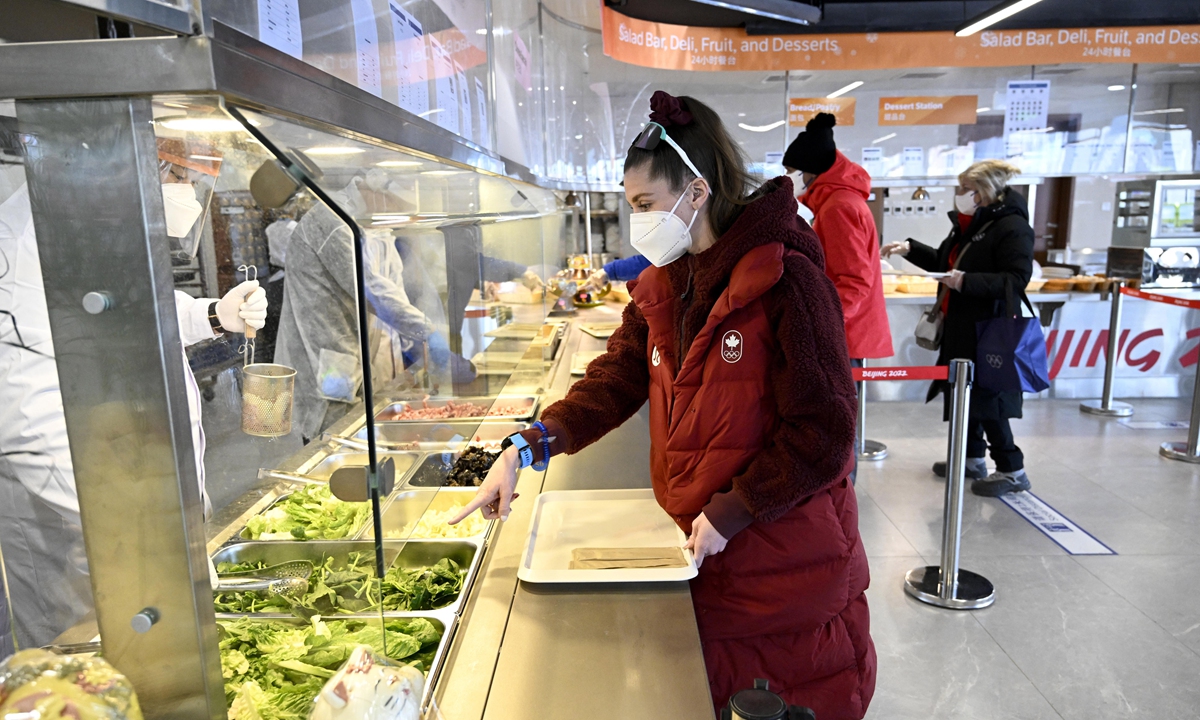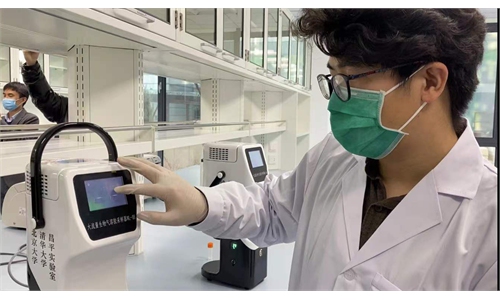How has China managed to host 'safest' Olympics amid pandemic?
Well-orchestrated measures win kudos from participants, a template for future games
Such an amazing result has blunted previous foreign media hype over the strict COVID-19 measures, after many smeared the policies for being too strict to enforce and that they would inconvenience the foreign athletes. They also warned the event would trigger widespread infections inside and outside the "bubble."
Epidemiologists believe China has handed athletes, participants of the Winter Olympics a "satisfactory" result in coronavirus control, and the low infection level within the loop proves the effectiveness and flexibility of China's overall zero-COVID policy.
The overall risk of COVID-19 at the event is under control as the Winter Olympics have passed the halfway point, said Huang Chun, a deputy director general of the Pandemic Prevention and Control Office of the Beijing 2022 Organizing Committee, at a Sunday press conference.
He responded to the previous situation where athletes said their nucleic tests results have been unstable, jumping between negative and positive. "It's not the problem of the test, as all the tests are conducted according to standard procedures," said Huang, explaining the unstable result may be caused by the intermittent detoxification process of the virus.
Participants at the Beijing Winter Olympics are confined to a "closed loop" to prevent contact with the general public, moving between accommodation and Olympic venues on official transport.
Every Games participant is tested daily to identify any infections within the loop quickly.
Huang said at a press conference last week that there is no cluster infection within the closed loop. According to information published on official website of Beijing 2022 Winter Olympics, 432 participants tested positive for coronavirus from January 23 to Monday.
Safe inside and outside
Before the opening ceremony, some foreign media sniped at the Games' COVID-19 policies, with some claiming they are too strict and have caused a "psychological burden" for athletes.
China has done a "stellar job" with COVID protocols, US freestyle skier Aaron Blunck said at a press conference on Sunday.
Blunck also criticized US media for their irresponsible reports during the press conference.
"I didn't really know what to expect being State-side. You heard some pretty bad media and that is completely false," Blunck said.
Blunck's remarks have been echoed by many other athletes.
Nevin Galmarini, a Swiss snowboarder staying in the Zhangjiakou Olympic Village told the Global Times that athletes get to choose when to test themselves, and "that's the good thing." He also praised the efficiency of the workers and said that it takes less than one minute to finish the test.
"We have to wear masks, social distancing. That's about it. The working personnel disinfect this whole place every day, many times a day, also where we live. But as I said, because of the situation we're in right now, it is perfectly understandable," Lithuanian alpine skier Andrej Drukarov, told the Global Times.
Swiss snowboarder Nicolas Huber, who was found to be an asymptomatic carrier and quarantined on arrival to China, also said the quarantine did not affect his training and competition.
According to the playbook which outlines anti-COVID-19 measures for the event, asymptomatic carriers are only allowed back into the village if they present two negative tests at least 24 hours apart, and have no other symptoms. If they return to the competition, they will have to adhere to the measures for close contacts.
"I think China is doing a great job of organizing the Olympic Games, one of the biggest sports events in the world during pandemic," said Galmarini.
Huang said there are four isolation facilities and one hospital for people who test positive in the Beijing and Yanqing competition areas.
Brian McCloskey, chairman of the Beijing 2022 medical expert panel said on February 8 that all COVID-19 prevention measures are based on science. "The medical expert panel has been meeting regularly," he said. "We've been looking at the evidence as it emerges from around the world and applying that to the protocols we have developed here."
Beijing is the "safest place on the planet" given its anti-coronavirus measures taken during the Winter Olympics, said McCloskey.
Juan Antonio Samaranch, chairman of the IOC Coordination Commission for Beijing 2022 told the Global Times in early February that "The closed-loop is working, is safe. Probably the safest place on Earth today," while noting that the number of positive cases upon arrival is manageable.
Apart from mandatory requests for participants, China has adopted many hi-tech measures to quickly detect the coronavirus, such as a bioaerosol nucleic acid detection system to test the air in the stadium and paste that detects one's temperature.
KingMed Diagnostics, a company in charge of nucleic acid tests at more than 50 sites within the closed loop, told the Global Times that it is capable of analyzing more than 30,000 tubes on daily basis and it takes on average six hours to get a result.
Huang said that last week there were no positive results from spectators, who enter and exit venues via a special passage so they do not come into contact with people inside the loop.
Xing Lida, a Beijing resident who watched the speed skating last Thursday said spectators must do two nucleic acid tests within 48 hours before the event, and another two within 48 hours afterward.
They were also warned against going to densely populated places within a week after attending an event, according to the rules.

An athlete orders food at a restaurant at the Olympic Village on February 1, 2022, in Beijing. Photo: VCG
'Real bubble'
Such an outstanding effort in keeping COVID-19 in control within the bubble also won plaudits from some foreign media, who previously throw mud at China's policies.
Recently, when reporting on the COVID-19 situation within the "bubble," many foreign media, including AFP and NPR admitted China is doing a great job controlling infection of the event. "Beijing's ambitious Olympic COVID bubble: So far, so good," wrote the Associated Press.
A reporter from Japan told the Global Times that he was impressed by the strict anti-epidemic system for the Games, saying that the efforts are "well-thought-out" and made him reassured in the "real bubble" in Beijing.
The reporter said that not only foreigners but also volunteers and other Beijing residents who work in the closed loop must stay inside, which is different from that of Tokyo Olympics.
"I didn't do interviews for the Tokyo Olympics, but I heard that people in the bubble of Tokyo 2020 were able to move freely after a certain period of isolation. This time in Beijing, it's a big difference," said the journalist.
Although it is a pity that they cannot enjoy local food outside the closed loop, the journalist said he did not feel inconvenienced.
Emre Aytekin, a journalist with Turkey's Anadolu Agency who covered the torch relay for the Beijing 2022 and other related events, has to present his negative results for nucleic acid testing within 48 hours, health code and telecommunication data-based travel itinerary card and go through security checks each time he enters the 2022 Beijing Media Center for the Beijing 2022 Winter Olympics.
He told the Global Times that journalists have to obey these rules because of the pandemic, and he understands the Chinese perspective as the virus is harmful to public health and especially given that China has a large population.
"So I respect these rules and try to follow them as much as I can," he said.
Satisfactory results
The COVID-19 policies adopted by the Olympics mirror China's dynamic zero-COVID policy, and prove that such a policy can be used flexibly under complicated circumstances like the Olympics, Wang Guangfa, a respiratory expert at Peking University First Hospital, told the Global Times.
He believes China has offered the athletes, participants a "satisfactory" result in controlling the coronavirus during the games.
Zhuang Shilihe, a renowned immunologist, told the Global Times that the Winter Olympics never set out to pursue the goal of zero cases, otherwise it will break the balance of keeping infection under control and letting athletes to compete. "The experience accumulated during the Winter Olympics could provide a template for the Asian Games Hangzhou 2022, which will be expected to welcome more participants."
Epidemiologists believe the COVID-19 measures within the closed loop, which achieved such a good result, could serve as a pilot for the further border opening of China post the pandemic, as the event adopted relatively relaxed measures compared with outside the bubble. For example, the event dropped the CT value of nucleic test from 40 to 35, making it easier for competitors to produce a negative test.
Some foreign media also worried that another challenge lies when some working staff from the Winter Olympics come out of isolation and trigger infections.
Zhuang brushed off the possibility, saying that the staff are young, have received booster shots and will undergo strict medical observation before leaving isolation. "The risk for them to cause infection is even lower than the sporadic transmission in ports and airports."

Beijing 2022's closed loop management. Infographics: GT/Chen He


